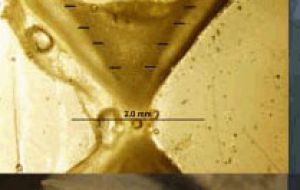MercoPress. South Atlantic News Agency
Skate recovered three years after tagging in the Falkland's waters
 Bathyraja cousseauae tagged in October 2006 and caught in February 2009 showing growth increments.
Bathyraja cousseauae tagged in October 2006 and caught in February 2009 showing growth increments. THE fishery around the Falkland Islands is rich and diverse, with the main fisheries focussed on a variety of squid and finfish. Furthermore, the area is also widely inhabited by a number of skate species, a family closely related to sharks.
In all, 18 species have been identified, some occurring only deeper than about 1000m, others only in shallow waters of 100m or less, but the majority in the depth range between 100-250m. The fishery for these species totals between 4.500-5.500 tonnes per year, and mainly takes place between 100- 250m.
To be able to manage the exploitation of these and any other fish stocks well, and provide sound advice, it is important to know as much as possible about the biology and life cycle of the species, such as where spawning areas are, how many young they produce annually, what their growth rates and age at a certain size are, what their feeding habits are, and what migrations might occur.
Fish are generally assessed for their age by analysing calcified parts in their head called otoliths or earbones. Annually a thin dark (winter) and a broad light (summer) zone are laid down as the otolith grows, and so the age can be assessed by a straightforward count of these, very much like rings on a tree. Fisheries observers collect around 4000 of these from fish such as hoki, hake, blue whiting, toothfish etc. annually, and their ages are assessed either by a laboratory in Poland, or here in the Fisheries Department.
Skates however do not have otoliths, but other options to assess age are to look at the growth rings in structures such as the vertebrae and the thorns on the tail.
This works well, and the growth rates for many shark and skate species have been established worldwide in this way. In the Falklands, ages and growth rates have so far been established for three of the major skate species, with others to be added over time.
Partly for this reason, skates have been tagged and released onboard Fisheries research vessels Cordella and Dorada, with around 4,500 tagged skates at liberty to date. The animals were all measured and weighed at sea, a plastic tag inserted near the tail and given an injection with an antibiotic called oxytetracycline, or OTC.
This chemical is absorbed in calcified structures that are being laid down at the time of injection and for a period thereafter and so can later on be used as a time marker.
After eventual recapture, the animal is weighed and measured again, and the vertebrae and thorns removed and viewed under a microscope with a ultra violet light, which makes the chemical fluoresce.
The fluorescing mark can then be used to confirm that the assumed annual rings are indeed annual and confirm the accuracy of age estimates that have been arrived at.
In early March, Falkland flagged trawler Venturer caught a Bathyraja cousseauae with tag number 731 close to Beauchêne Island. It had been tagged in October 2006 onboard Dorada, and was returned to the Fisheries De Department last week. A reward of $25 - was given to the crew member who spotted it. The skate had grown 5cm in length and had increased in weight from 1315g to 1810g. It was caught 7Nm from where it was released.
Following some quick processing and analysis of sections of the vertebrae and some thorns, it appeared that the fluorescent mark was clearly visible and appeared just after six growth increments on both structures. More importantly, two clear winter marks were evident following the OTC mark and this was followed by rapid growth which is assumed to be that which occurred in summer 2008-2009. Although we have had a few tagged animals returned to us in the past, they had never been long enough at liberty to be able to confirm that the growth rings were indeed annual, and so one can imagine the excitement this recent find caused. It is hoped that we will get more of these animals returned to us in future to help improve our understanding of the biology and life cycles of these fascinating creatures.
A current study into the age and growth rates of this skate species shows that these skates grow to about 130cm in length and reach an age of about 20 years. The validation of these growth increments adds a significant level of confidence to the quality of the work.
By Joost Pompert – Penguin News - Stanley




Top Comments
Disclaimer & comment rules-

Read all commentsMercopress editors, please beign more respectfull, malvinas inhabitants are not members of mercosur and the fact you call the islands falklands does not represent the view of mercosur members. I think this is just a british unnemployed idea to make monney from and, at the same time, lobbying for the “falklands” cause.
May 03rd, 2009 - 10:38 am 0PD: why dont you call this falklandpress instead of mercopress.
At least respond my email sended to you.
Commenting for this story is now closed.
If you have a Facebook account, become a fan and comment on our Facebook Page!